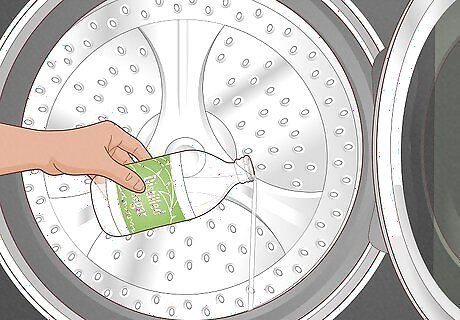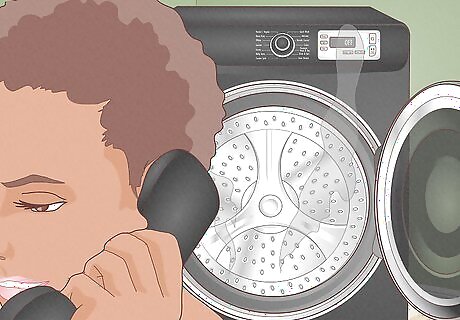
views
- Wipe down the rubber gasket inside of the door with warm, soapy water.
- Clean the soap dispenser with soapy water to remove any detergent residue.
- Run an empty cycle with the hottest water temp available to clean the drum out.
- Add a few cups of distilled white vinegar and run an empty cycle if the odor still persists.
Cleaning the Gasket and Drum

Scrub the gasket around the door with soapy water. This is the rubber strip on the door and inside that provides a tight seal when the door shuts. Soak a rag in dish soap and water. Wring the excess water out, and open the door of the machine. Thoroughly scrub down the rubber seal that runs around the ring of the machine. You can also use a commercial mold or mildew cleaner or a 50/50 mix of bleach and water. Just be sure to wear gloves and a dust mask if you do! The gasket seals the machine and keeps water from leaking out. Unfortunately, that means it tends to absorb a lot of water and moisture. Over time, this can lead to all kinds of moldy, stuffy odors. Cleaning the gasket after each load can seriously go a long way towards keeping odors out of your machine.

Wash out the soap dispensers out with soapy water. If the dispensers come out, remove them to make this easier. Scrub down the soapy residue. Then, rinse the dispenser out thoroughly to wash away all the soap scum and bubbles. Soap residue and small amounts of old stagnant water can make your dispensers smell a little funky. Over time, this can contribute to that moldy, mildewy aroma you’re smelling. Use a spray bottle or pipe cleaner to get into the nooks and crannies of the dispenser if you can’t remove it.

Run an empty wash cycle to rinse and wash the drum. If your washing machine has a “cleaning cycle” setting, run that. Otherwise, run an empty cycle on the highest temperature for the longest period of time possible. If you can set custom water levels, fill the machine entirely. This should wash away any residual odors and unpleasant aromas.

Add distilled white vinegar to your wash to purge strong odors. If your machine still smells after an empty wash cycle, run another cycle but add 2-3 cups of (1/2-3/4 L) of distilled white vinegar to the drum. This will put an end to any musky scents. If you’re worried specifically about germs or bacteria, you can also add a few spoonfuls of chlorinated bleach to the machine. Just make sure you run another empty cycle after to wash away any remaining bleach. And never mix vinegar and bleach together! They create harmful vapors when combined, so go with one or the other. You probably don’t have actual mold in your machine if you use it regularly, but if you do, the vinegar will kill it. Do this entire process every 1-2m moths to prevent any odors from building up.

Call your manufacturer or a repair company if the problem persists. Cleaning the gasket, wiping the dispenser, and running a vinegar cycle should remove the moldy odor 100%. If it still stinks, something is wrong with your machine. If you’re under warranty, contact the company that made or sold you the machine. Otherwise, call a repair company. You can try cleaning out the filter—there may be something smelly stuck in there. Alternatively, you might try clearing the machine drain.
Preventing Moldy Odors

Use a high-quality liquid detergent designed for your machine. Most High Efficiency (HE) machines require HE detergent, so check the packaging to see if it’s designed for your machine. Skip the powder stuff, since it tends to leave more residue and odors behind after wash cycles. Using non-HE detergent will cause too many suds to form if you have an HE washing machine. These suds will leave behind a residue that can start to smell.

Use dryer sheets instead of liquid fabric softener. Fabric softener works by coating the clothes in a very thin liquid that soaks into the fabric. Some of that fabric softener can end up sticking to the sides off the drum, which can lead to some unpleasant odors. Dryer sheets aren’t really good for your clothes, either. You really don’t need to use either product, but if you’re forced to, dryer sheets are better if you want to avoid odors in the washing machine.

Air out the washing machine between loads. Keep the door open for an hour or two after you use the washing machine and transfer your clothes to the dryer. This will help your drum dry out and avoid any moisture from contributing to that damp, mildew smell in the future. If you have small children, keep them away from washing machine while you’re airing it out. Kids tend to like jumping into empty washing machines and can get stuck.

Remove wet clothes immediately after the cycle finishes. Right after a cycle ends, take the wet clothes out. Leaving the wet clothes in the drum can cause that damp mildew odor to develop. Set your washer to beep when a cycle is complete, so you don't forget to take the clothes out. If you can't dry your clothes right away, take them out and put them in a hamper or lay them flat until the dryer is available.




















Comments
0 comment